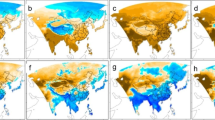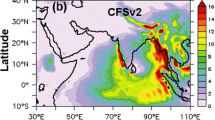Abstract
In this work the sensitivity of the Weather Research and Forecasting (WRF) model to a choice of parameterization modulating the cloud-radiation feedbacks is assessed. Two 5-year (1990–1994) climate simulations covering Europe were conducted using WRF-ARW v3.6.1 with 0.44° spatial resolution. In the base-case, WRF does not consider cumulus cloud feedbacks to radiation, while in the modified case the subgrid-scale cloudiness associated with convection, is taken into account. The results are compared with the base case and the differences for shortwave downward radiation at the surface, total cloud cover and convective available potential energy (CAPE) are discussed. Our analysis indicates that including subgrid-scale cumulus clouds in the radiation scheme leads to a decrease of shortwave radiation at the surface and convective precipitation. The behavior of CAPE is more complex and can be either decreasing (southern Europe) or increasing (northern Europe).
Access provided by CONRICYT-eBooks. Download conference paper PDF
Similar content being viewed by others
Keywords
- Iberian Peninsula
- Regional Climate Model
- Cloud Fraction
- Convective Available Potential Energy
- Convective Parameterization
These keywords were added by machine and not by the authors. This process is experimental and the keywords may be updated as the learning algorithm improves.
1 Introduction
The most important processes that determine the climate and its variability are the interactions between atmospheric radiation, clouds and aerosols. In climate modeling clouds are crucial because affect the climate through interactions with the Earth’s radiation budget and the hydrological cycle, influencing in this way several meteorological fields. However, until recently, these feedbacks processes were not traditionally included in subgrid-scale convective parameterizations used in regional climate models. As a consequence, the radiation passed through the atmosphere nearly unimpeded, resulting in simulations with excessive radiation, convective precipitation and available potential energy, but with little cloudiness especially during the summer.
The objective of the present study is to investigate the impact of subgrid-scale cloud/radiation feedbacks on radiation at the surface, cloudiness and CAPE during summer. This feedback process incorporated into a convective parameterization and a radiation scheme in the Weather Research and Forecasting model. Alapaty et al. (2012) found that the simulation of meteorological parameters, such as shortwave and longwave radiation, CAPE and cloudiness is affected, when the sub-grid scale cloudiness is taken into account. In our study we want to investigate the impacts of subgrid-scale cloud/radiation feedbacks over Europe.
2 Data and Methodology
2.1 Data
In the present study the two different climate simulations were performed with WRF-ARW (version 3.6). The simulations cover Europe with a horizontal resolution of 0.44°. Both simulations were forced by the ERA-Interim reanalysis data (Dee et al. 2011). The configuration of both simulations is presented in Table 1. The numbers in parenthesis correspond to the selected option according to the namelist input of WRF3.6.1. Activation of the cumulus radiation feedback option (cu_rad_feedback = true) in the modified case allows for sub-grid cloud fraction interactions. The analysis includes mean surface temperature (T2), convective precipitation (Prc), shortwave downward radiation at the surface (DSW), available potential energy (CAPE) and total cloud fraction (CF).
2.2 Methodology
The Kain-Fritsch (KF; Kain 2004) convective parameterization is modified to provide feedbacks to RRTMG radiation schemes in WRF. Two different regional climates simulations are performed. In the first one (hereafter “base” case), WRF does not consider cumulus cloud feedbacks to radiation, while in the second (hereafter “modified” case) the subgrid-scale cloudiness associated with convective clouds, is taken into account. All variables were averaged for the time period of interest (1990–1994). Both simulations used one year (1989) as spin-up time. Summer months are June to August (JJA). All seasonal averages were calculated based on mean monthly values and include all hours for each day. Only cells over land are taken into account. The analysis was performed over the whole European domain and over the following subregions: Alps (AL), British Isles (BI), Eastern Europe (EA), France (FR), mid-Europe (ME), Mediterranean (MD), Iberian Peninsula (IP) and Scandinavian Peninsula (SC).
3 Results
Figure 1 shows the differences between the modified and base case for mean summer temperature, shortwave radiation, CAPE and CF over Europe averaged for the time period 1990–1994. The introduction of the subgrid-scale cloud feedbacks to radiation changes substantially the shortwave (DSW) radiation. In the modified case the DSW radiation at the surface decreases and cloud fraction increases. The reduction in radiation at the surface, can lead to less buoyant energy, and thus in smaller CAPE, which seems to be the case for southern Europe. These finding are in accordance with the study of Herwehe et al. (2014) for North America, who showed that the impact of subgrid-scale cloud radiation interactions leads to a reduction of the DSW radiation at the surface during the summer. A different regime is seen in our simulations over northern Europe, with increased CAPE and reduced DSW radiation.
Figure 2 depicts the annual cycle and the interannual variability of convective precipitation over Europe, which is very low during the cold months and maximizes in summer, when convection is mostly active. It is clear that the implementation of subgrid-scale cloud radiation interactions in WRF produced less convective precipitation in the summer months and this is systematic. The annual cycle of CAPE, convective precipitation, DSW radiation and total cloud cover for two subregions, Scandinavian and Iberian Peninsula in the northern and southern part of Europe respectively, is depicted in Fig. 3. Over Scandinavia SW radiation, CAPE and convective precipitation maximizes in July, while at the same time the CF reaches its minimum (0.4 in July). Over the Iberian Peninsula the CAPE-maximum is higher (up to 300 J/kg) and broader compared to the Scandinavia extending from June to August. Cloud fraction ranges from 0.1 to 0.4 and reaches its minimum in July, being always lower than the CF of northern Europe.
In the modified case compared to the base case, DSW radiation at the surface decreases mostly during the warm months, when convection is more active. Convective precipitation is also affected during the summer months and decreases mostly in southern Europe and for a more extended period (March to October). CAPE has a more complex behavior, increasing over Scandinavia and decreasing over the Iberian Peninsula. It is expected to see a decrease of CAPE, when there is less SW radiation at the surface (seen over southern Europe), but less straightforward to explain the mean increase of CAPE over Scandinavia. Given the dependency of CAPE on both temperature and humidity, the complex interactions between the variables through different atmospheric processes (radiation, convection, evapotranspiration) and the multiple land-atmosphere feedbacks (temperature, precipitation and soil moisture) is not so easy to explain the behavior of CAPE, unless a more thorough analysis is performed, including components of the hydrological cycle and the energy budget. This analysis could be part of future work.
4 Conclusions
Two regional climate simulations were examined and compared for Europe. In the base case the interactions between the subgrid-scale clouds and radiation schemes were not taken into account, while in the modified case this feedback was included. First results indicate that including subgrid-scale cloud interactions with radiation, leads to a decrease of SW radiation reaching the surface during the warm months, when convection is mostly active. Convective precipitation decreases as a result of less active convection, especially in the south. The behavior of CAPE depends on the different European climate regimes, and can be either decreasing (southern Europe) or increasing (northern Europe). A more thorough analysis of the different parts of the hydrological cycle and the surface energy budget would be necessary in order to be able to explain in depth those finding.
References
Alapaty K, Herwehe JA, Otte TL, Nolte CG, Bullock OR, Mallard MS, Dudhia J (2012) Introducing subgrid-scale cloud feedbacks to radiation for regional meteorological and climate modeling. Geophys Res Lett 39:L24808. doi:10.1029/2012GL054031
Herwehe JA, Alapaty K, Spero TL, Nolte CG (2014) Increasing the credibility of regional climate simulations by introducing subgrid-scale cloud-radiation interactions. J Geophys Res 119:5317–5330
Kain JS (2004) The Kain–Fritsch convective parameterization: an update. J Appl Meteorol 43:170–181. doi:10.1175/1520-0450(2004)043<0170:TKCPAU>2.0.CO;2
Dee DP, Uppala SM, Simmons AJ, Berrisford P, Poli P, Kobayashi S, Andrae U, Balmaseda MA, Balsamo G, Bauer P, Bechtold P, Beljaars ACM, van de Berg L, Bidlot J, Bormann N, Delsol C, Dragani R, Fuentes M, Geer AJ, Haimberger L, Healy SB, Hersbach H, Hólm EV, Isaksen L, Kållberg P, Köhler M, Matricardi M, McNally AP, Monge-Sanz BM, Morcrette J-J, Park B-K, Peubey C, de Rosnay P, Tavolato C, Thépaut J-N, Vitart F (2011) The ERA-Interim reanalysis: configuration and performance of the data assimilation system. Q J R Meteorol Soc 137:553–597. doi:10.1002/qj.828
Acknowledgments
The climate simulations have been performed in the EGI/HellasGrid infrastructures.
Author information
Authors and Affiliations
Corresponding author
Editor information
Editors and Affiliations
Rights and permissions
Copyright information
© 2017 Springer International Publishing Switzerland
About this paper
Cite this paper
Vavritsa, M., Katragkou, E., Kartsios, S., Pytharoulis, I., Karacostas, T.S. (2017). Sensitivity Study of Cloud-Radiation Feedbacks in a Regional Climate Model Simulation Over Europe. In: Karacostas, T., Bais, A., Nastos, P. (eds) Perspectives on Atmospheric Sciences. Springer Atmospheric Sciences. Springer, Cham. https://doi.org/10.1007/978-3-319-35095-0_96
Download citation
DOI: https://doi.org/10.1007/978-3-319-35095-0_96
Published:
Publisher Name: Springer, Cham
Print ISBN: 978-3-319-35094-3
Online ISBN: 978-3-319-35095-0
eBook Packages: Earth and Environmental ScienceEarth and Environmental Science (R0)







